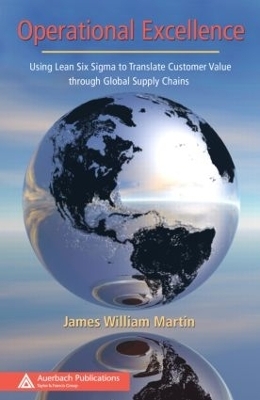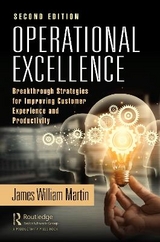
Operational Excellence
Using Lean Six Sigma to Translate Customer Value through Global Supply Chains
Seiten
2007
Auerbach (Verlag)
978-1-4200-6250-2 (ISBN)
Auerbach (Verlag)
978-1-4200-6250-2 (ISBN)
- Titel erscheint in neuer Auflage
- Artikel merken
Zu diesem Artikel existiert eine Nachauflage
Presenting 110 key concepts designed to translate the voice of the customer throughout global supply chains, this source offers information for organizations seeking to increase productivity and improve shareholder satisfaction. It shows how to increase global competitiveness through the application of Six Sigma.
To successfully compete in today’s global marketplace, organizations can and must do more to improve their internal operational efficiencies. Operational Excellence: Using Lean Six Sigma to Translate Customer Value through Global Supply Chains consolidates hundreds of tools and methods into 110 key concepts designed to translate the “voice of the customer” throughout global supply chains, dramatically improving productivity and shareholder economic value added (EVA). Recognizing failure is often self-induced through poor leadership coupled with an inability to form and effectively execute a strategic vision, this book operates from three premises—
Organizations have the power to increase organizational competitiveness in an era of globalization through the application of Lean Six Sigma
Operational performance directly correlates with an organization’s financial, operational and resultant productivity, as well as with shareholder EVA metrics, and geographical, cultural, technological and economic isolation
Value-adding activities and disciplines such as Lean Six Sigma are not exclusive to any one country or region and do not always depend upon cost considerations
A Practical Tool for Real World Application
For organizations seeking a source for improving manufacturing and service operations, this bookeffectively delivers. Divided into 5 successive sections, it begins with adaptation strategies for global competitiveness, then delves into implementations to enhance productivity while targeting customer needs and value expectations. Finally, the author explains how to establish information-sharing throughout global supply chains, along with the role of IT. A useful tool for real world application, the volume’s 20 chapters also contain more than 450 figures and roadmaps. As organizations understand the interrelationships of the supply chains, their operational systems will excel at meeting or exceeding customer expectations in this age of globalization.
To successfully compete in today’s global marketplace, organizations can and must do more to improve their internal operational efficiencies. Operational Excellence: Using Lean Six Sigma to Translate Customer Value through Global Supply Chains consolidates hundreds of tools and methods into 110 key concepts designed to translate the “voice of the customer” throughout global supply chains, dramatically improving productivity and shareholder economic value added (EVA). Recognizing failure is often self-induced through poor leadership coupled with an inability to form and effectively execute a strategic vision, this book operates from three premises—
Organizations have the power to increase organizational competitiveness in an era of globalization through the application of Lean Six Sigma
Operational performance directly correlates with an organization’s financial, operational and resultant productivity, as well as with shareholder EVA metrics, and geographical, cultural, technological and economic isolation
Value-adding activities and disciplines such as Lean Six Sigma are not exclusive to any one country or region and do not always depend upon cost considerations
A Practical Tool for Real World Application
For organizations seeking a source for improving manufacturing and service operations, this bookeffectively delivers. Divided into 5 successive sections, it begins with adaptation strategies for global competitiveness, then delves into implementations to enhance productivity while targeting customer needs and value expectations. Finally, the author explains how to establish information-sharing throughout global supply chains, along with the role of IT. A useful tool for real world application, the volume’s 20 chapters also contain more than 450 figures and roadmaps. As organizations understand the interrelationships of the supply chains, their operational systems will excel at meeting or exceeding customer expectations in this age of globalization.
Six Sigma Integration, Inc., Rehoboth, Massachusetts, USA
Adapting Strategies for Global Competitiveness. Translating Customer Value into Products, Services, and Workflow Systems. Operations Planning, Management, and Control. Collecting, Analyzing, and Sharing Information across a Supply Chain. Global Supply Chain Management.
| Erscheint lt. Verlag | 27.12.2007 |
|---|---|
| Zusatzinfo | 215 Tables, black and white; 238 Illustrations, black and white |
| Verlagsort | London |
| Sprache | englisch |
| Gewicht | 1065 g |
| Themenwelt | Technik ► Umwelttechnik / Biotechnologie |
| Wirtschaft ► Betriebswirtschaft / Management ► Logistik / Produktion | |
| ISBN-10 | 1-4200-6250-6 / 1420062506 |
| ISBN-13 | 978-1-4200-6250-2 / 9781420062502 |
| Zustand | Neuware |
| Haben Sie eine Frage zum Produkt? |
Mehr entdecken
aus dem Bereich
aus dem Bereich
Grundlagen - Spezialthemen - Übungen
Buch | Softcover (2022)
Springer Gabler (Verlag)
CHF 55,95



